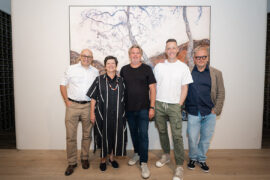Representing a new breed of entrepreneurs, New Zealand-based makers Trèlogy communicate their business through the lens of a unique design language.

June 11th, 2014
Words Sophia Watson
How important is the story of your business compared to the product itself? For many, the product wins out every time. For artisan makers Trèlogy however, it is all about the story.Here, these kiwi’s have focused their business on the story of their brand – where the tale informs the design itself, and ultimately communicates a unique language of who they are through the design of their products.
For founder and now managing director, Andrew Davies, the story of Trèlogy is his homeland. “My family have been timber craftsman since the mid-19th century,” says Davies. “After a furniture fair in Queenstown in September 2011 for our original company: Davies Furniture, I flew my wife Mary-Jayne and our two young boys down to Glenorchy for the weekend at the end of Lake Wakatipu. We did a few bush walks, and then came to a cross road – turn right to go back to Queenstown, or left to paradise. Needless to say we turned left and drove to the end of the road and ended up at Chainman’s Bluff. We talked about sharing this landscape with the rest of the world, and connecting people in metropolitan cities to nature. It got to after dusk and we were leaving to drive back to Queenstown when three wild deer ran out in front of the car, stopped, and looked at us. I turned to Mary-Jayne and said ‘This is a sign, I need to share this experience with the rest of the world’. We got together a great creative team to form Trèlogy, and build on connecting people to nature through functional art.”
Shortly after his life-changing experience, Davies joined forces with Christchurch designer Richard Simpson to develop the products and “bring the story to life.”
“Andrew [Davies] has built a superb brand with an amazing story behind it,” says Simpson, “and I see my role to complete the story is to create products in harmony with the brand.”
The products themselves are the physical manifestation of Trèlogy’s story, with a strong focus on bringing nature and people together through sustainable bespoke designs. Simpson explains: “We see the brand as a vehicle to create a dialogue, and define the company through our design language,” – a language that many are beginning to speak. Having recently won the Best Design Award for the 2012 New Zealand Design Awards, Trèlogy’s Umber chair was chosen to represent the best of New Zealand design at the 2013 Gwangui Design Biennale in Korea, an achievement demonstrating the value of a well-emphasised design language. With plans to move into the US market including LA and New York, Davies and Simpson explain that: “we don’t want to be the biggest, we just want to be the best.”
TRÉOLOGY
INDESIGN is on instagram
Follow @indesignlive
A searchable and comprehensive guide for specifying leading products and their suppliers
Keep up to date with the latest and greatest from our industry BFF's!

Sydney’s newest design concept store, HOW WE LIVE, explores the overlap between home and workplace – with a Surry Hills pop-up from Friday 28th November.

For those who appreciate form as much as function, Gaggenau’s latest induction innovation delivers sculpted precision and effortless flexibility, disappearing seamlessly into the surface when not in use.

London-based design duo Raw Edges have joined forces with Established & Sons and Tongue & Groove to introduce Wall to Wall – a hand-stained, “living collection” that transforms parquet flooring into a canvas of colour, pattern, and possibility.

Designed by PAN- PROJECTS, Earthboat is a series of mobile cabins set across the mountainous regions of Japan and built entirely with Japanese cedar CLT.

In an age where the concept of the workplace is an increasingly transient notion, we expect more from the places where we conduct our business than ever. Shaw Contract, your Official Partner of the INDE. Workspace Award, is here to make sure that happens!
The internet never sleeps! Here's the stuff you might have missed

Indesign Media is aware of recent reports raising serious concerns about Australian architectural photographer Derek Swalwell.

Eco Outdoor recently brought together developers, sustainability experts and local architects such as Adam Haddow to discuss design fundamentals, carbon targets and long-term thinking.